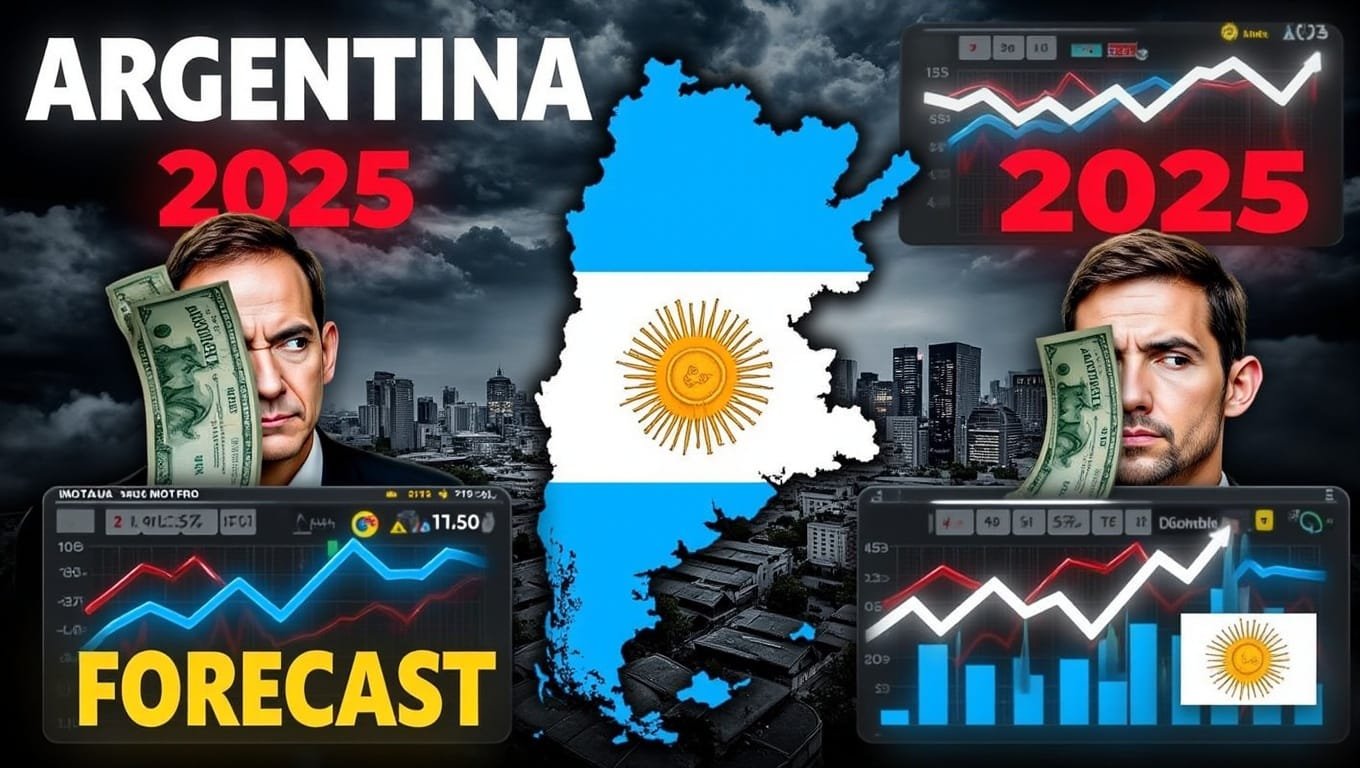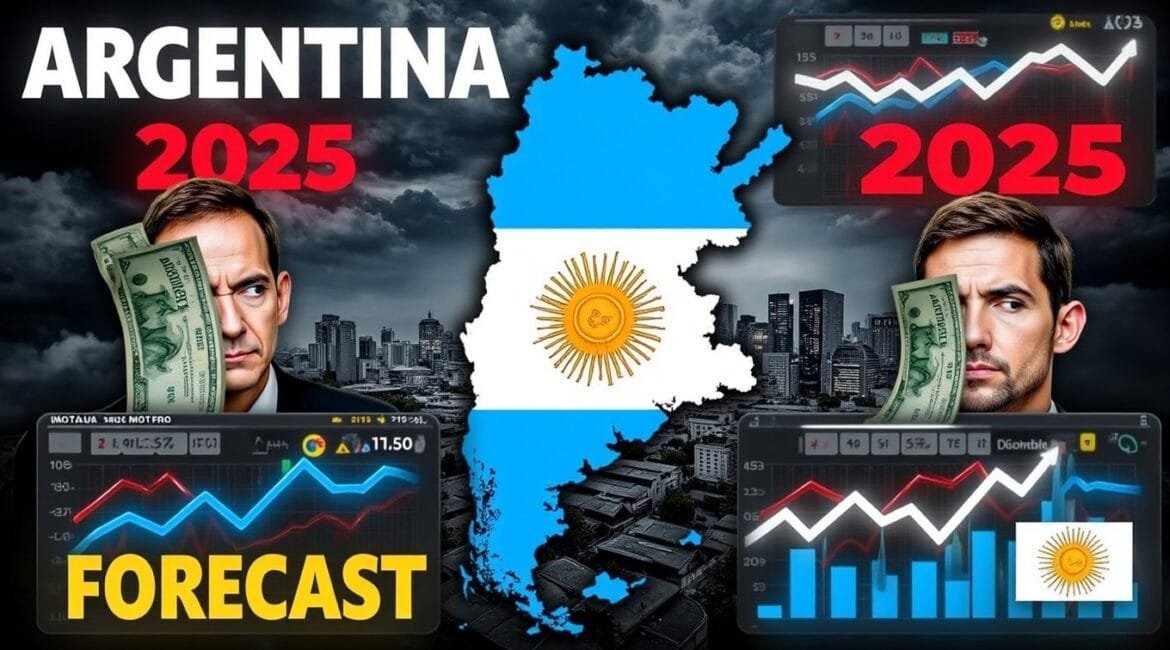8 minutes read time.
The Argentina economy has been plagued by political and economic scandal on the international front for decades with periods of prosperity being followed by financial crises of very high magnitude. Owing to the reality that the economic history of the nation is marred by high inflation, currency devaluation, and political instability, Argentina has had one of the most difficult economic experiences in Latin America. As Argentina nears 2025, several things are being called into question: Will Argentina finally stabilize its economy? Will inflation subside? What sectors will make the economy grow?
This in-depth report encapsulates the most significant economic news for Argentina in 2025, ranging from GDP forecasts, inflation, employment numbers, foreign investment, government policy, and sectoral expansion. Regardless of whether you are a businessperson, entrepreneur, economist, or merely interested in finding out what the future holds for Argentina, this post provides you with an in-depth and knowledgeable view of what we can foresee in the coming year in regard to opportunities and challenges.
The Current State of Argentina Economy: A Historical Perspective
In order to have a vision where Argentina economy is headed in 2025, there needs to be a vision of where it has been over the last few years. Argentina has seen cyclical fiscal crises that have in great part been caused by structural economic vulnerabilities, poor fiscal policy, and external shocks. Among the most significant issues that Argentina has encountered are:
• Hyperinflation: In 2023, inflation levels were well over 100%, aggressively cutting into buying power and making long-term budgeting all but impossible for firms and individuals alike.
• Currency Devaluation: The Argentine peso lost much value against the US dollar, with the loss of faith in the national currency and increasing reliance on the parallel dollar exchange rate (blue dollar).
• Crisis of Debt: Argentina has struggled with sovereign debt crises for generations, perpetually negotiating with the International Monetary Fund (IMF) and creditors.
• Erratic Investment Environment: High rates of inflation, volatile economic policy, and excessive capital controls have discouraged foreign direct investment (FDI), undermining growth prospects.
• Decline in Real Salaries and Joblessness Problem: With inflation permanently exceeding wage increments, real salaries have decreased, leading to rising informal employment as well as underemployment.
Though these problems have ravaged the nation, there have been a few sectors that have survived the tempest, and 2025 can be the year Argentina is reborn—if policies are properly established. But will the government be able to stabilize the economy and revive investor confidence?
GDP Growth: Can Argentina Achieve Economic Expansion in 2025?
Argentina economy growth forecast for the GDP in the year 2025 is put into question mainly due to the success of the government in curbing inflation and reactivating the economy. Some foresee slow growth of 2% to 3%, while others foretell that Argentina will be in a stagflation process where there is inflation but there is no dynamism in the economy.
Factors That Could Drive GDP Growth in 2025
Several key factors could contribute to positive economic expansion in 2025:
- Agriculture and Commodity Exports: The nation is a world leader in terms of beef exports, wheat export, soybeans export, and lithium export. In the event that the commodity price is positive on the world stage, then agriculture would be the first sector to drive economic growth.
- Defense and Technology Industry Investment: Since Argentina possesses some of the world’s largest lithium deposits, investment in clean tech, battery production, and renewable energy can be a driver of industrial development.
- Tourism Rebound: The devalued peso is turning Argentina into a desirable tourist spot, and it can be buoyed by the hotel, leisure, and retail sectors.
- Investment in Infrastructure: In the event that the government places special focus on PPPs in transport, digital connectivity, and infrastructure, economic activity will grow significantly.
- Trade Policy and Reforms: In the event of Argentina’s increased trade cooperation with China, Brazil, and the European Union, exports and fresh capital inflows will increase.
Risks That Could Limit Growth
However, there are some major risks which can hamper GDP growth, including:
- Sustained Inflation: If inflation persists above 60%, it will be difficult to achieve long-term economic growth.
- Difficulties in Debt Payment: If Argentina does not repay its IMF loans, investors’ confidence will be lost, and the economy will contract further.
- Inability to Reach Political Agreement on Reforms: If the government is unable to approve major economic reforms, instability will persist, discouraging both local as well as foreign investments.
- Increasing Poverty and Social Unrest: Economic recession has been accompanied by increasing social unrest, and large-scale protests or strikes can bring business operations and economic progress to a grinding halt.
The big question for 2025 is whether Argentina can implement the necessary structural reforms to attain economic growth with social stability.
Inflation in Argentina: Can Prices Finally Be Controlled?
Inflation has always been Argentina’s biggest economic challenge, reaching triple-digit figures in 2023. While other Latin American countries have managed to control inflation using monetary instruments and independent central banks, Argentina has not fared so well due to:
- Excessive money printing to finance government deficits.
- Unconfidence in the peso, which causes continuous devaluation of currency.
- Distorting market forces with subsidies and price controls.
Inflation Outlook for 2025
In the case of 2025, economists project inflation to decline to 50% to 80%, subject to the government:
- Cutting government spending and fiscal deficits.
- Adopting a tighter monetary policy in an attempt to curtail money creation in excess.
- Liberalizing the currency through unification of exchange rates or managed devaluation.
- Sustaining private investment with the purpose of improving productivity.
In spite of all these, Argentina’s inflation rate will remain among the highest in the world, making life tough for its citizens and businesses.
Argentina’s Labor Market: What to Expect in 2025?
Employment Trends and Wage Challenges
The rate of unemployment in Argentina has been stable to a large extent, but the wage crashed due to inflation. The labor market will be dependent on in 2025
- Job creation in new industries like technology, agriculture, and energy.
- Deflation-adjusted wage policy for safeguarding employees’ purchasing power.
- Incentives of institutional work to reduce reliance on casual employment.
While certain industries might prosper, employees will pay the price if inflation isn’t checked.
Foreign Investment: Is Argentina an Attractive Market in 2025?
Argentina has never been able to attract long-term foreign investment, mainly due to policy uncertainty, capital controls, and inflation. There would probably be increased investment in strategic sectors, however.
- Lithium and Renewable Energy: Argentina is the world’s largest producer of lithium, a key input for the electric vehicle (EV) industry.
- Agribusiness: With its extensive fertile land, export agriculture and agritech can be financed to seek foreign investment.
- Technology Startups: Foreign investors would be attracted to fintech and software development opportunities if Argentina were to encourage tech entrepreneurship and digital innovation.
Challenges for Investors
In spite of these opportunities, foreign investors are still apprehensive, mainly because of:
- Unpredictable and unforeseeable government policies at short notice.
- Sophisticated tax and labor laws that increase business costs.
- Prohibitions on capital repatriation, which prevent withdrawal of profits from the nation.
In order to turn Argentina into a more investor-attractive nation, the administration must accord top priority to policy stability, judicial transparency, and economic liberalization.
Conclusion: Will Argentina Find a Path to Stability? 
Argentina economy in 2025 is at a crossroads. On the plus side, it has gigantic natural resources, a strong export-based foundation, and an unbelievably highly qualified labor force, but on the downside, it is behind in currency devaluation, political instability, debt, and inflation.
If there are stable government policies and Argentina concentrates on stability in economic rather than populist policies in the short run, then there is the possibility of a moderate reversal. Without structural changes, there will be ongoing high inflation, falling wages, and little foreign investment.
2025 would be the year of opportunity and threats for businesses, investors, and workers. Depending on their ability to face the uncertainty, either profitable chances may be unearthed by them or otherwise they will find themselves in deep sufferings.
Argentina economy destiny remains in the balance today—hanging by a thread of bold action—and the world holds its breath.
This article is intended solely for educational purposes and provides general information. It should not be interpreted as financial, investment, or any other form of personalized advice. The author assumes no responsibility for any decisions, actions, or outcomes resulting from the use of the information provided in this article. It is recommended that the reader consult a qualified professional before making any financial or investment decisions.
The images used on this site are sourced from free image banks such as Pixabay, Freepik, and Pexels. Additionally, some images and textual content may be generated or assisted by artificial intelligence tools. While the author makes every effort to ensure the accuracy and quality of the provided information, there is no guarantee of financial or other benefits resulting from the application of this information. The use of this content is solely the responsibility of the reader.
The author also assumes no responsibility for inaccuracies or any distortions caused by the use of artificial intelligence in the generation of content, whether textual or visual. It is always recommended that the reader seek guidance from a qualified professional to validate and interpret the information contained in this article.



Innovative perspective! Sprunki cross-genre blending tools let users create hybrid tracks that defy traditional categorization.